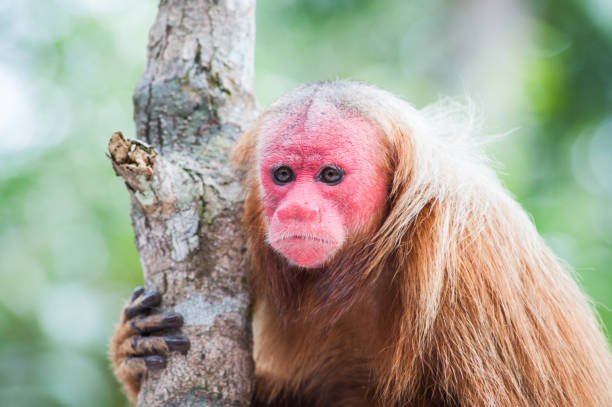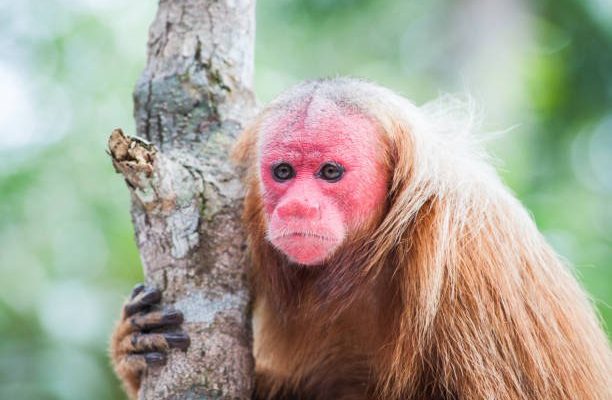
To answer that, let’s dive into what makes the Uakari tick, its behavior, and whether it poses any real threat to us humans. Picture it like this: You’re out on a hike, surrounded by the sounds of nature, and suddenly you spot a Uakari swinging through the trees. It’s cute, but should you be cautious? Let’s explore this question together.
What is a Uakari?
The Uakari is a type of monkey that belongs to the genus *Cacajao* and is part of the family Pitheciidae. They are particularly famous for their striking appearance. Most notably, they have a bright red face and a bald head, which can look pretty quirky. *Uakari* comes from the indigenous Brazilian word meaning “the one who has a small face.” These monkeys are usually medium to large in size, with adults weighing up to about 15 pounds.
Uakaris are typically found in the flooded forests of the Amazon River Basin. They prefer areas where water levels can rise and fall dramatically, which provides an abundance of food throughout the year. They mainly feed on fruits, seeds, and other plant materials. Their diet also includes insects, which adds a bit of protein to their meals. The way they forage for food is quite fascinating, often using their strong hands and keen sense of smell.
Uakari Behavior and Social Structure
You might be wondering how Uakaris interact with one another. These monkeys are very social creatures, living in groups of around 10 to 30 individuals, commonly referred to as troops. Within these troops, you can find a complex social hierarchy that helps them establish relationships and ensure safety.
Social bonds are crucial for Uakaris. They spend a lot of time grooming each other, which helps strengthen these relationships. This behavior not only keeps their fur clean but also provides comfort and reduces stress within the group. Picture it as a monkey spa day—everyone gets pampered while also reinforcing their social ties.
In terms of communication, Uakaris use a variety of vocalizations, facial expressions, and postures to express their feelings and intentions. Their interactions can range from playful chases to serious squabbles, much like a group of friends hanging out. So how do these social dynamics play into their potential danger?
Are Uakaris Aggressive?
Here’s the thing: Uakaris are generally not known for being aggressive towards humans. They tend to avoid contact and stay high up in the trees, which is their safe haven. Even though they have strong jaws and teeth, their first instinct is usually flight rather than fight. They don’t want to get involved in conflicts with larger predators or humans.
However, just like any wild animal, Uakaris can exhibit aggression if they feel threatened. If you were to corner one or get too close to their young, it might react defensively. This can involve loud vocalizations or even displays of aggression, like showing their teeth. But it’s important to remember that these situations are rare, and Uakaris would much rather keep their distance from people.
Potential Risks and Health Concerns
While Uakaris themselves aren’t inherently dangerous, there are some health concerns to consider. One of the most significant issues is the risk of diseases that can be transmitted between animals and humans. Uakaris can carry parasites and viruses, which might pose a risk if humans come into direct contact with them.
For instance, *Bacterial infections* and *parasitic diseases* are common in wild primates. They can spread to humans through bites or scratches or even just through surfaces they’ve touched. This makes it crucial to keep a respectful distance from these animals if you ever encounter them in their natural habitat.
Additionally, it’s not just about the Uakari itself; the environments they live in can also harbor other dangers. Venomous snakes, insects, and other wildlife can present risks. When exploring the rainforest, taking precautions is just as important as being aware of the Uakari.
How to Observe Uakaris Safely
If you’re lucky enough to find yourself in Uakari territory, you probably want to watch them in action. But safety first! Here are a few tips to observe Uakaris without putting yourself at risk:
- Maintain a Safe Distance: Use binoculars or a camera with a zoom lens to enjoy the view without getting too close.
- Stay Calm: Sudden movements or loud noises can scare them away. Keep your excitement in check!
- Educate Yourself: Understanding their behaviors and social dynamics can help you appreciate them more and know how to act around them.
- Respect Their Habitat: Stay on marked trails and avoid disturbing their living environment.
By observing these simple guidelines, you can ensure that both you and the Uakaris remain safe during your wildlife encounters.
Alternatives to Interacting with Uakaris
If you’re really interested in these cute primates but want to avoid any potential risks, consider alternative ways to connect with them. Here are a few options:
- Documentaries: Many nature documentaries showcase Uakaris in their natural habitat. They often detail their behaviors, diets, and social structures.
- Virtual Tours: Some wildlife organizations offer virtual tours or interactive experiences to learn about Uakaris and other wildlife without physical interaction.
- Conservation Support: Contributing to wildlife conservation organizations helps protect Uakaris and their habitats from environmental threats.
Engaging with Uakaris in these ways allows you to admire them while promoting their safety and well-being.
So, can the Uakari be dangerous to humans? The short answer is no, not really. While they can display aggression if they feel threatened, Uakaris are generally shy and prefer to avoid contact with humans altogether. Their quirky appearance and social nature make them endearing, but it’s always crucial to approach wild animals with respect and caution.
By understanding their behavior and knowing how to observe them safely, you can enjoy the beauty of these remarkable creatures without any unnecessary risks. Whether through documentaries or respectful wildlife watching, there are many safe ways to appreciate Uakaris and learn about their role in the Amazon ecosystem. Just remember: these lively monkeys thrive in their own world, and it’s best to admire them from a distance.

